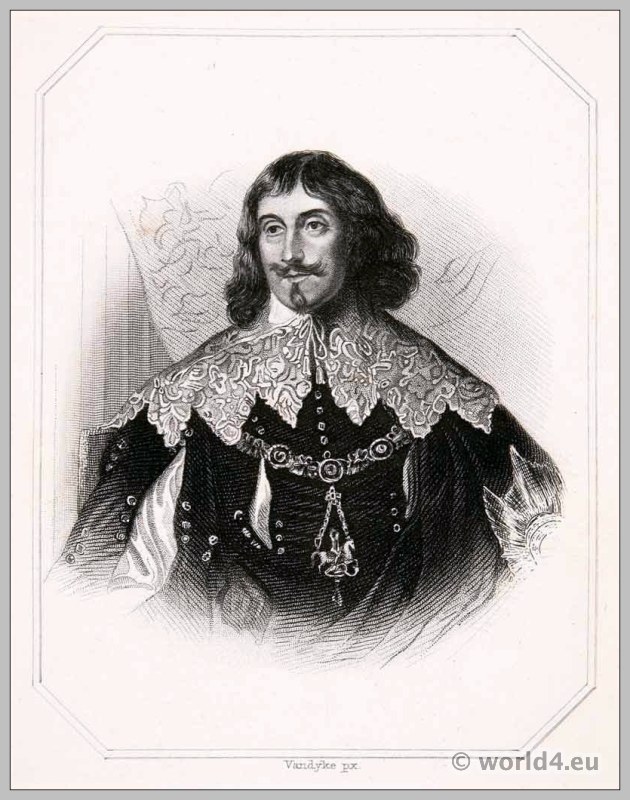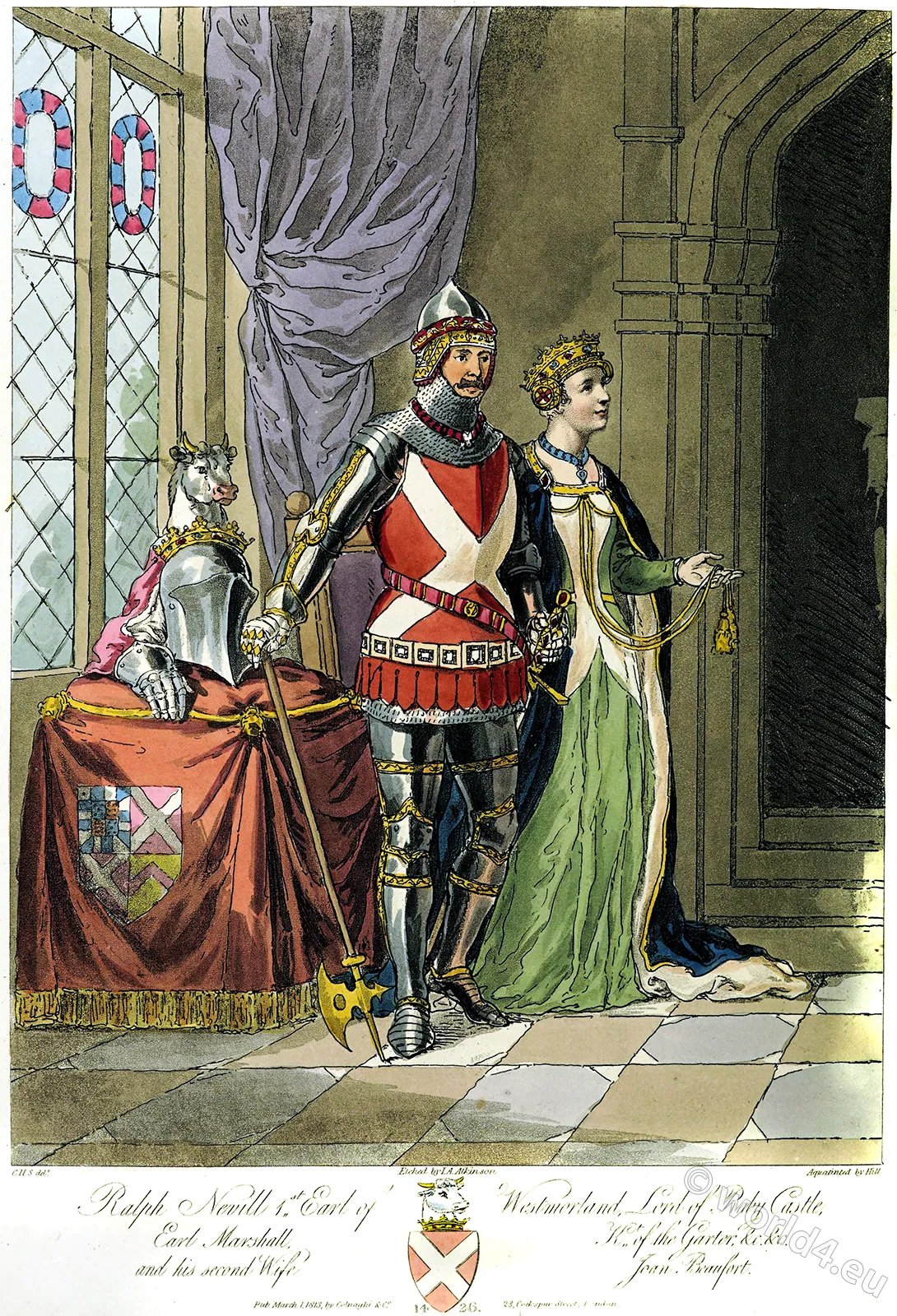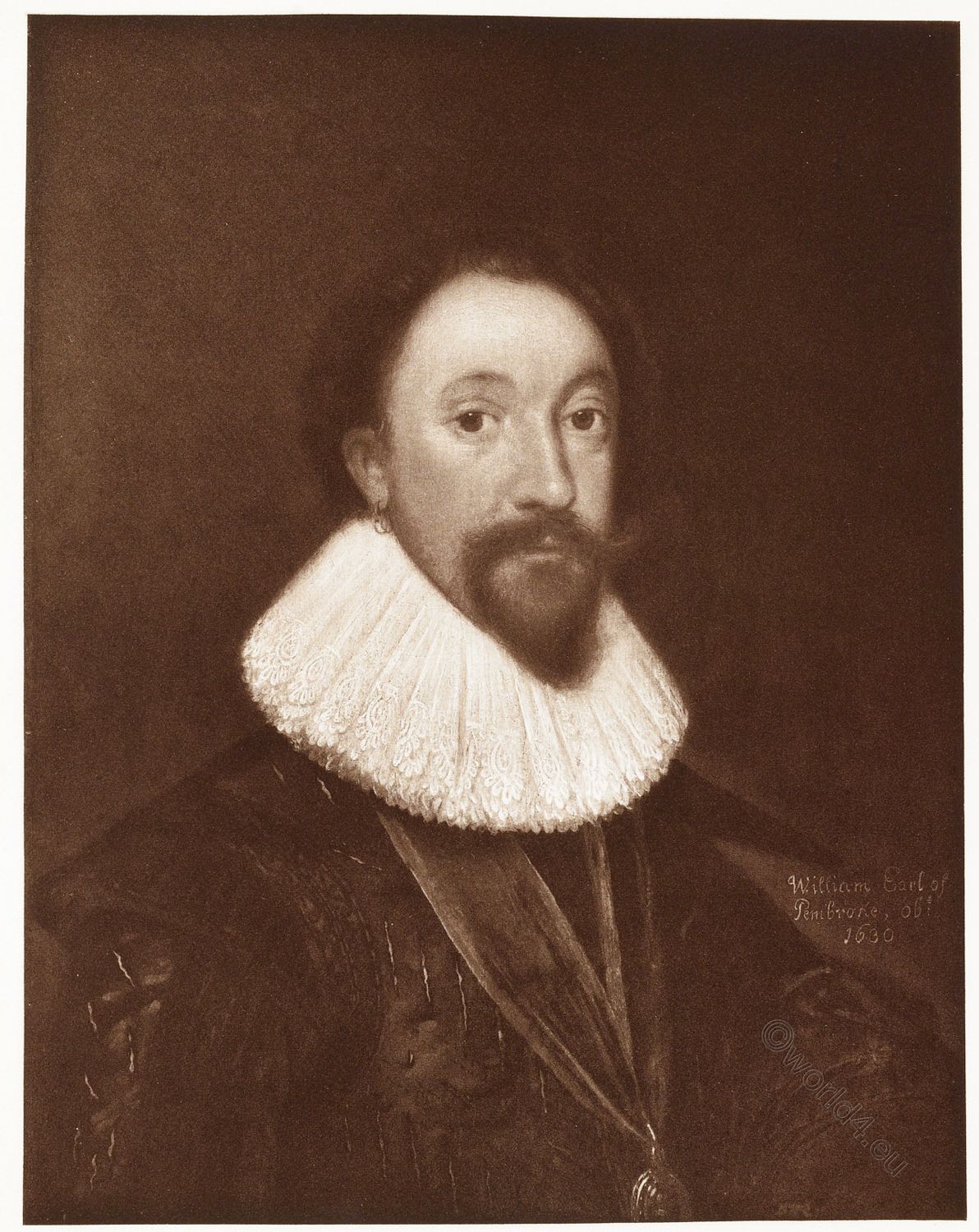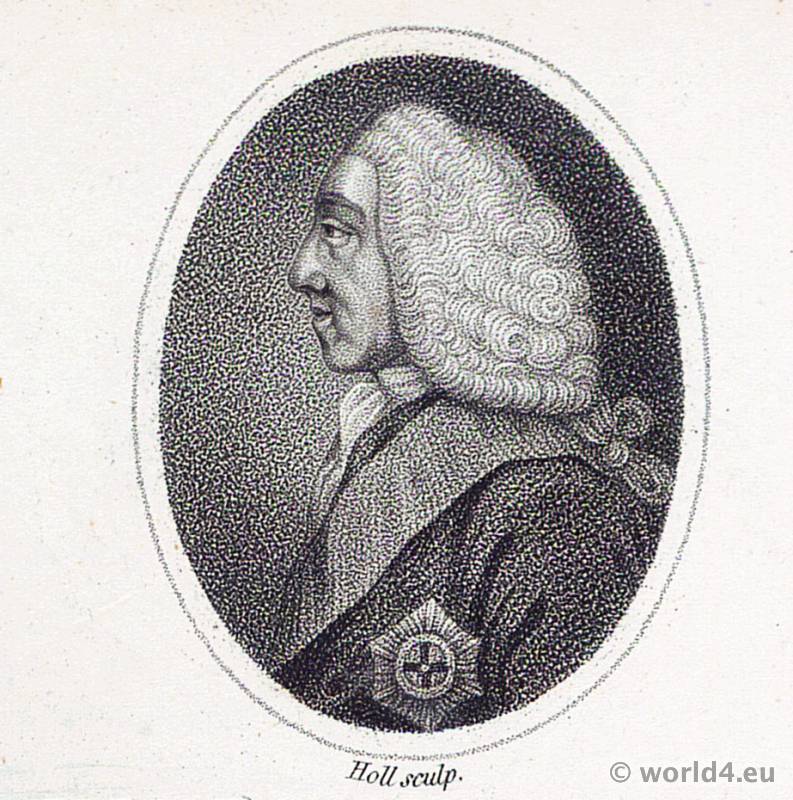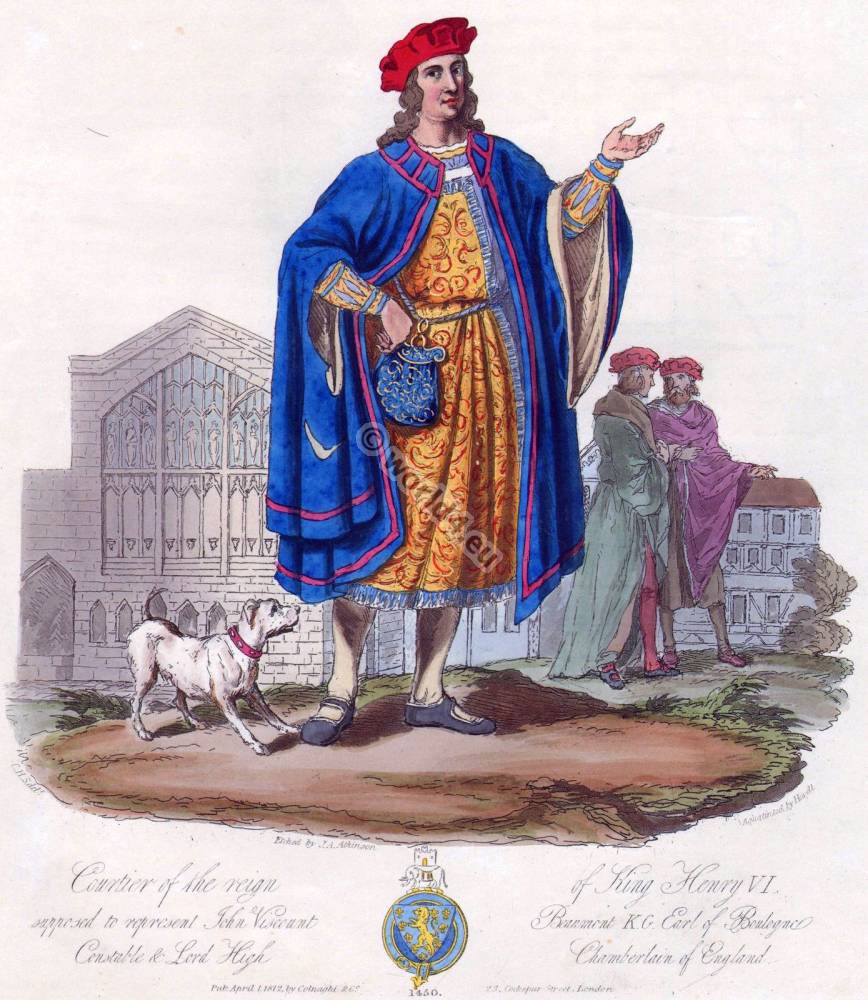Philip Herbert, 4th Earl of Pembroke and 1st Earl of Montgomery
Philip Herbert, 4th Earl of Pembroke and 1st Earl of Montgomery (1584-1650) was an English courtier and politician active during the reigns of James I and Charles I. Philip and his older brother William were the ‘incomparable pair of brethren’ to whom the First Folio of Shakespeare’s collected works was dedicated in 1623.
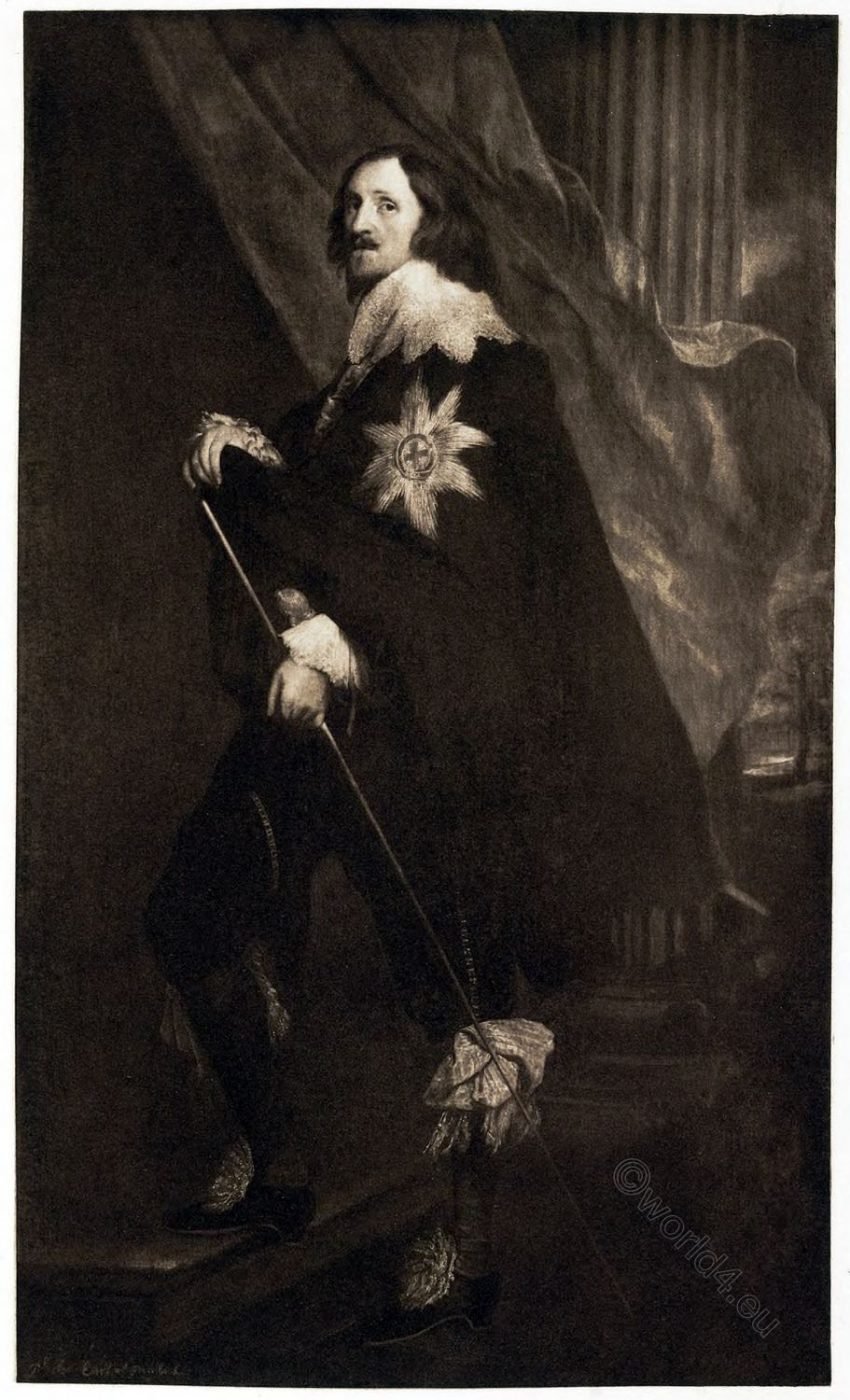
PHILIP, FOURTH EARL OF PEMBROKE. WILTON HOUSE PICTURES.
SIR ANTHONY VAN DYCK. 87 in. H. 54 in. W. Canvas. Double Cube Room (at Wilton House).
Full length, standing, turned to the right, foot raised on a step; wearing black knee breeches, tied with large pink and white striped bows, and gray stockings. With his right hand he raises a black cloak, on which is embroidered the Star of the Order of the Garter, while he holds in his left the long white wand of Lord Chamberlain. His long brown hair falls over a deep lace collar, and he wears a neatly trimmed pointed beard and mustache. Behind his head floats a rich red curtain, and in the background is a single fluted pillar. In the left-hand bottom corner is painted” Philip, Earl of Pembroke.”
Although somewhat disfigured by restoration and injured by neglect, this portrait is still a magnificent example of Van Dyck as regards richness of coloring and dignity of composition. There is unfortunately no record which enables us to give accurately the date of its execution; we can only conjecture from the apparent age of the sitter that it was painted about the year 1630.
Philip, second son of Henry, second Earl of Pembroke, by his third wife, the famous Mary Sidney, was born in 1584. He came early to Court, and was mentioned by Howe, in his Chronicle for Sunday, 24th July, 1603, as having “received the Order of the Knighthood of the Bathe”: again, Rowland Whyte, writing to Robert Sidney on the 20th April, 1600, says: “Mr. Philip Harbert is here (at Court) and one of the forwardest Courtiers that ever I saw in my time, for he had not been here two hours but he grew as bold as the best.” His advancement in King James’s Court is attributed by Clarendon to “the comeliness of his person his skill and indefatigable industry in hunting.” In 1605 he was created Baron Herbert of Shurland, in the Isle of Sheppy in Kent, 1) and Earl of Montgomery by patent dated” June. 4. James I.” Three years later he was installed a Knight of the Garter, having been previously appointed a Gentleman of the King’s Bedchamber.
With regard to the Earl’s matrimonial affairs, we find that in April, 1597, “Little Mr. Philip Harbert” was reported to be a suitor for the hand of Mary Herbert, heiress of Sir William Herbert of St. Julians, 2) who ultimately married Edward, Lord Herbert of Cherbury; in 1601 his father offered the Queen £5,000 if she would allow a royal ward, daughter of Sir Robert Gorges, to marry him, but the offer was declined. 3)
1) “Shurland, or Shirlonde, was once the seat of an eminent family of that name, and formerly was a very large house built in the form of a quadrangle or square, but now tis almost down. The last of the name of Shurland who resided here was Sir Robert de Shurland, who was made Knight Banneret by King Edward I. in his 28th year. (By his daughter and heir, who married Sir William de Cheney, it passed into that family.) His descendant Sir Henry Cheney was created Lord Cheney of Tuddington, and exchanged the Manor of Shurland with Queen Elizabeth by which means it came to the Crown, and there it staid until the second year of K. James I. and then was granted to Philip, Earl of Montgomery, and after Earl of Pembroke: and in Philpots time was the estate of his second son Mr. James Herbert, in whose family it still continues: being now in the possession of James Herbert Esq Knight of the Shire for Oxfordshire.”-Harris, History of Kent, 1719, book i, p. 108.
The Manors of Middleton and Marden were granted to Philip, Earl of Pembroke, by James I, as was also Northwood Manor.-Ibid., p. 209.
2) Sir William was descended from Sir George Herbert, Knt., third son of William, the first Earl of Pembroke (of the first creation).-Collins.
3) Rowland Whyte to Sir Robert Sidney, 10th May, 1600. “A sentence is given in the court of wards, against Sir Arthur Gorge, that his daughter is the Queen’s ward; which sentence was by the judges of the land confirmed, who were called unto it; and I believe, young Mr. Philip Harbert shall have her, for my lord of Pembroke offers the Queen £5,000, in money and jewels.” Again, 31st May, 1600: “Yt is doubted, that Mr. Philip Harbert shall not have the Queen’s ward; for that Sir Arthur Gorge, the father, doth make great meanes to her Majestie, that he may have the disposing of her before any other, and intends her for my Lord of Howards son.”-Sidney Papers, vol. ii, p. 193.
After” long love and many changes” he was, in October, 1604, “privately contracted to my Lady Susan (Vere, third daughter of Edward, seventeenth Earl of Oxford] without the knowledge of any of his or her frendes” (Lodge, Illustrations, iii, 238). 1) The marriage was celebrated at Whitehall on the 27th December of the same year with great ceremony. Mr. Chamberlayne writes to Mr. Winwood, from London, 18th December, 1604:
“Here is a great provision for Cockpit, to entertain the King at home, and of masks and revels, against the marriage of Sir Philip Herbert and Lady Susan Vere, which is to be celebrated on St. John’s day” (Winwood’s Memoirs, vol. ii, p. 41). Again Sir Dudley Carleton writes to Mr. Winwood, January, 1604-5:
“On St. John’s day we had the marriage of Sir Philip Herbert and the Lady Susan performed at Whitehall, with all the honour could be done a great favourite. The court was great; and for that day put on the best bravery. The Prince and Duke of Holst led the bride to church; the Queen followed her from thence. The King gave her; and she in her tresses and trinkets brided and bridled it so handsomely, and indeed became herself so well, that the King said, if he were unmarried, he would not give her but keep her himself.
“The marriage dinner was kept in the great chamber, where the Prince and the Duke of Holst, and the great lords and ladies, accompanied the bride. The Ambassador of Venice was the only bidden guest of strangers, and he had place above the Duke of Holst, which the Duke took not well. But after dinner he was as little pleased himself; for being brought into the closet to retire himself, he was then suffered to walk out, his supper unthought of.
1) 16th October, 1604. Earl of Pembroke to Earl of Shrewsbury. “My LORD,
“Though I have no direct messinger to send unto your Lordship, I rather chose to write by post than leave you unadvertised of that which is as joyful unto me, as any thing that ever fell out since my birth. I cannot now write unto you all the circumstances; but at coming down, your Lordship shall know as much as myself. The matter in brief is, that, after long love, and many changes, my brother on Fryday last, was privately contracted to my Lady Susan, without the knowledge of any of his or her frendes. On Saturday she acquainted her uncle with it, and he me. My Lord of Cranbourn seemed to be much troubled with it at the first: but yesterday the King taking the whole matter on himself, made peace on all sides … wishing your Lordship all the happines this earth can afford, I rest your Lordships most affectionate sonne, to serve you.
“PEMBROKE.”
” At night there was a mask in the hall, which for conceit and fashion, was suitable to the occasion. The actors were, the Earl of Pembroke, the Lord Willoby, Sir Samuel Hays, Sir Thomas Germain, Sir Robert Cary, Sir John Lee, Sir Richard Preston, and Sir Thomas Bager. There was no small loss that night of chaines and jewells, and many great ladies were made shorter by the skirts, and were well served that they could keep cut no better. The presents of plate and other things given by the noblemen were valued at £2,500; but that which made it a good marriage was a gift of the King’s, of £500 land, for the brides jointure.
“They were lodged in the council chamber, where the King, in his shirt and night-gown, gave them a ‘reveille matin’ before they were up …. No ceremony was omitted of bride cakes, points, garters, and gloves, which have been ever since the livery of the court; and at night there was sewing into the sheet, casting off the bride’s left hose, with many other petty sorceries.”
Rowland Whyte, writing to Lord Shrewsbury, gives a far more flattering account of young Sir Philip than does Clarendon: “The young worthy,” he writes, “Sir Philip, grows great in his Ma’ favor, and carries it without envy; for he is very humble to the greate lords, is desirous to doe all men good, and hurtes no man.” Whyte, in another letter, quotes the following lines:
The Herberts every Cockepit day,
Doe carry away
The gold and glory of the day.
At the Coronation of Charles I, the Earl of Montgomery carried the spurs. About the year 1625, Philip succeeded his brother in the office of Lord Chamberlain, a position he held until 1641; the cause of his dismissal is set forth in the following letter, which is to be found in the Tanner MSS. 66, fol 110. “Sir, my loving Cousin . . . last Saturday there was a controversy between ye Lord Chamberlayne and ye Lord Matravers: ye Lord Matravers gave my Lord Chamberlayne ye Lye; wherupon he strucke Matravers over the head with his staffe: then ye Lord Matravers took up a Standish & threw at ye Lord Chamberlayne; this moved so great a Stirre y’ ye Committee did rise, complaynt was made to His Majesty and on Monday ye Upperhouse committed ym both to ye Tower. (Sd) Robert Appleton. Grayes Inn. July 23rd 1641.” 1)
It is not possible in this short memoir to follow in detail his doings during the contest between King and Parliament: having succeeded in 1630 to his brother’s vast estates, his influence was eagerly sought by both sides, but he seems to have committed himself definitely to neither.
1) To this account Clarendon, vol. i, p. 263, adds: “The King, taking advantage of this miscarriage, and having been long incensed by the passionate, indiscreet, and insolent carriage of the Earl, sent to him by a Gentleman Usher for his Staff; and within two or three days after, bestowed it on the Earl of Essex.”
Clarendon thus sums up his policy during the struggle:
“The Earls of Pembroke and Salisbury were so totally without credit, or interest in the Parliament, or country, that it was no matter which way their inclinations or affections disposed them; and their fear of the Faction that prevailed, was so much greater than their Hatred towards them, that though they wished they might rather be destroyed than the King, they had rather that the King and his Posterity should be destroyed than that Wilton should be taken from one of them, or Hatfield from the other: the preservation of both which from any danger they both believed to be the highest point of prudence and politick circumspection.”
There is no doubt that his sympathies lay with the Parliament, and that this was generally recognized is patent from the following extract taken from Fasti Oxonienses, p. 32: “An. Dom: 1643. 19 Car. I. Chancellor: the same viz Philip Earl of Pembroke and Montgomery &c: but he being thought unworthy to have the said office by the King and University, forasmuch as he was actually against the former in the present war, and altogether neglected the other, the King authorized the members thereof to make choice of another: whereupon they calling a convocation on the 24th October did elect for their Chancellor Will: Marquess of Hertford.” Visiting Oxford in 1648, the Earl was but ill-received, as the following lines, taken from a contemporary lampoon entitled “An Owl at Athens; a relation of the Earle of Pembroke’s entrance into Oxford; April 12th 1648,” sufficiently show:
His bristles stood thin and for want of growth
Like toadstools raised by th’ thunder of his mouth.
His nose was notch’d like country garden pales,
His brow and chin more mountainous than Wales,
And who could better fill Apollo’s place,
Than he that bears Parnassus in his face? 1)
The King’s cause having failed, the Earl makes his position with the Parliament secure by entering the Lower House; “a writt is to issue out (Feb. 23rd 1648) for a member of the House to be elected instead of Sir Francis Pile, deceased, for a place in Berkshire. The Earl of Pembroke is amongst the people cryed up to be the man they will chuse, and it is said that if they do chuse him his Lordship will sit a cheerful Commoner in the House of Commons.” 2) On Monday the 16th April, 1649, he was admitted into the House, and took his place there, having been chosen Knight of the Shire for Berkshire. 3)
1 Tanner MSS. Eng. Poet., e. 4, p. 142. Other satires published at the time include “Pegasus or the Flying Horse from Oxford” and “Newes from Pembroke to Montgomery, or Oxford Manchestered,” with Pembroke’s speech “word for word and oath for oath.”-Dict. Nat. Biog.
2) Sydney Papers, Blencowe, 1825, p. 68.
3) Ibid., p. 72.
While in this strange position of Nobleman-Commoner he and his crony, Michael Oldsworth, 1) fell under the lash of Samuel Butler’s satire; bantering speeches were published, purporting to have been delivered by the Earl, of which the following is an example, and one especially interesting from its reference to the fire at Wilton.
The Earl of Pembroke’s speech in the House of Peers when the seven Lords were accused of High Treason. Copia vera, Mic: Oldsworth.
“My Lords, you know I seldom make speeches … will you for this clap me in the Tower? You sent me thither six years ago for but handling a standish, and now you’ll commit me for writing my name. . . . If I needs must go, I pray you, send me home to Baynards Castle or Durham House (a damnable fire burnt my house at Wilton, just that hour I moved your lordships to drive malignants out of London) …. I thank God I have a good estate of my own, and I have the estates of my Lord Bayning’s children, and I have my Lord of Carnarvon’s estate, these are my three estates. . . . Remember I beseech you that I am an old man; I have been a grandfather time out of mind (for I was so when this parliament began).”
Butler’s satire in verse was still more virulent, and was no doubt greatly intensified by party feeling; it is scarcely credible that the object of the attack could have deserved the epithets so bitterly heaped upon him; these lines show the venom with which the author of Hudibras tinged his shafts:
Pembroke’s a Covenanting Lord
That ne’er with God or Man kept word.
One day he’d sware he’d serve the King,
The next ’twas quite another thing;
Still changing with the Wind and Tide
That he might keep the stronger side.
His Hawks and Hounds were all his Care
For them he made his daily Prayer,
And scarce would lose a hunting Season
Even for the sake of darling Treason.
Had you but heard what thunder-claps
Broke out from his and Oldsworth’s chaps,
Of Oaths and horrid Execrations
Oft with, but oftener without, passion,
You’d think these Senators were sent
From Hell, to sit in Parliament.
When King Charles left Oxford for Colebrook, and the Parliament had their garrison at Reading, the Earls of Northumberland and Pembroke were selected to carry the petition of both Houses to him, and were afterwards employed in similar services.
1) Michael Oldsworth, or Oldisworth, was born in 1591; beginning his career as Secretary to William, third Earl of Pembroke, then Lord Chamberlain, he became, through his patron’s influence, Member for Old Sarum in 1624, being re-elected in 1625-6-8. Replacing Taverner as Secretary to Earl Philip, he sat as Member for Salisbury both in the Short and Long Parliament of 1640. “Tho’ in the grand rebellion he was no Colonel, yet he was governor of old Pembroke and Montgomery, led him by the nose (as he pleased) to serve both their turns.”-Wood, Fasti, vol. i, p. 356. Oldsworth died in 1654. See Dict. Nat. Biog.
In 1643 the Earl was one of the twenty-two peers who remained sitting in the House at Westminster, or were engaged on the Parliament side, after the rest had withdrawn themselves out of duty and conscience, and met at Oxford to rally round the King. In r644, on the monarch’s return with his army from the West, part of the cannon and carriages were left at Wilton, the house of the Earl of Pembroke, with a regiment of foot to guard them.’
The description given by Anne Clifford of her second husband, Philip, is as follows, and shows that he was in various respects a far more considerable character than the criticisms of his political opponents would lead one to imagine. “He was no scholar at all to speak of; for he was not past three or four months at the University of Oxford, being taken away thence by his friends presently after his father’s death in queen Elizabeth’s time, at the latter end of her reign, to follow the Court, as judging himself fit for that kind of life when he was not passing fifteen or sixteen year old: yet he was of very quick apprehension, a sharp understanding, very crafty withall, and of a discerning spirit, but extremely choleric by nature, which was increased the more by the office of chamberlain to the King, which he held many years. He was never out of England but some two months, when he went into France, with other lords, in the year r625, to attend Queen Mary at her first coming over into England to be married to King Charles her husband. He was one of the greatest noblemen of his time in all respects, and was throughout the reign well-beloved.” 2)
Among the offices held by Earl Philip was that of Lord Warden of the Stannaries. By an early usage peculiar to the counties of Devon and Cornwall, the prerogative of the Crown, elsewhere reaching only to gold and silver mines, is extended to mines of tin, which are the property of the Sovereign, whoever may be the owner of the soil. A charter of King John to his tinners in these counties, of date 1201, authorized them to dig tin, and turf to melt the tin, anywhere in the moors and in the fees of Bishops, Abbots, and Earls, as they had been used and accustomed, a privilege afterwards confirmed by successive monarchs.
1) Collins.
2) The following letter from the Earl, written in 1643, and found in one of the Wilton Corporation Chests in 1816, suggests that the Countess was more capable of fighting her own battles than her biographers allow.
“DENNET,
“I have sent Pordage into the Country, that he might according to ye power I have granted to him, keep my Courts, as my stuard, and therefore I expect of you and Gamblett to assist him therein, and to shew him what belongs thereto, & what you doe for him in this I shall take as acceptable service to my selfe. I also will that you take his directions for ye securing the rents at this receipt, and that you be careful to charge all tenants not to pay any upon their perril, to any whomsoever, that shall demand it by order from my wife, or in pursuance of any Decreetal order of Chancery, and that you be very Carefull to secure all moneys safe, that it may not any ways fall into their hands, as well in Wales as in Wiltshire, for I have some reason to suspect my wife intends to seaze upon it if she can, weh yr dilligence and Care may p’vent, thus hoping you will punctually performe what I hereby desire,
“I remaine ye loveing master, “Sept. 27th” PEMBROKE. ” Baynards Castle.”
When Edward III created his son, the Black Prince, Duke of Cornwall, he at the same time conferred on him the Stannaries of Devon and Cornwall, which were incorporated in perpetuity with the Duchy. Their administration is committed to an officer called the Lord Warden of the Stannaries, who has two substitutes or Vice Wardens, one for Cornwall and one for Devon. 1)
The Earl’s tenure of this office met with the disapproval of Lord Clarendon, who complains that he extended the jurisdiction of the court” with great passion and fury.” 2) Of the Earl’s death we find the following account in the Sydney Papers, containing a rebuke which cannot be said to have been undeserved.
“Wednesday the 23rd January 1649. In the morning my cousin Germain, the Earle of Pembroke dyed at his lodgings in the Cockpit part of Whytehall, of a feaver and gangrene as I heard: just a week before Wednesday the 30th of January, that day that the late king was beheaded at Whytehall gate; so he lived not a yeare after it. He told me himself that out of his chamber window he looked upon the King as he went upstairs from the park to the galerye in the way to the place of his death, which was quickly after. That he should not have done, but retyred himself to pray for him and to lament his misfortunes, to whom he had so greate obligations.”
On the 9th February, the Earl’s body was laid in the Herbert vault in the Cathedral of Salisbury; by order of the Council of State all members of parliament accompanied the cortege two or three miles on the journey from London. A great bronze equestrian statue was cast to mark his last resting place, but it was never erected and has disappeared; 3) the probable site of the grave is now marked by a marble slab placed by the present Earl.
1) Chambers’s Encyclopedia, 1904, vol. ix, p. 682.
2) Clarendon, vol. i, p. 287.
3) “Philip … for whom a splendid monument was designed and to that end a fair statue of brass of an extraordinary size was cast, representing him in armour etc. now in the Earl of Pembroke’s seat at Wilton, but for what reason it was never erected I cannot tell.”-The History and Antiquities of the Cathedral Church of Salisbury, London, 1719, p. 107.
Source: Wilton house pictures; containing a full and complete catalogue and description … by Sidney Herbert Earl of Pembroke. London, Printed at the Chiswick press, 1907.
Related
Discover more from World4 Costume Culture History
Subscribe to get the latest posts sent to your email.

